A Two-Stage Voting-Boosting Technique for Ensemble Learning in Social Network Sentiment Classification
Abstract
1. Introduction
- This paper proposes a novel ensemble method called 2SVB. The proposed method utilizes a two-stage data processing approach that not only generates diverse data but also effectively utilizes erroneous data.
- We utilize a base classifier group comprising five PDL models with heterogeneous pre-training frameworks to enhance diversity. The selected base classifier group outperforms other combinations in terms of performance.
- The proposed method uses two-stage concurrent training and an ensemble framework that allows for concurrent computation of all training processes except for the erroneous-data-collection process. We also propose a concurrent ensemble method of cascaded voting for the stage-2 ensemble, which enhances the diversity of concurrent ensemble algorithms.
- Compared to other ensemble methods, the 2SVB method demonstrates better performance. Our research has the potential to enhance the accuracy of various applications, such as sentiment analysis, rumor detection, and hate-speech classification.
2. Related Works
2.1. Sentiment Classification
2.2. Ensemble Methods for Sentiment Classification
3. The 2SVB
3.1. Framework
3.2. Data Processing
3.2.1. Stage-1 Data Processing
3.2.2. Stage-2 Data Processing
3.3. Training
3.3.1. Base Classifiers
3.3.2. Stage-1 Training
3.3.3. Stage-2 Training
3.4. Ensemble
3.4.1. Ensemble Methods
| Algorithm 1 Cascade voting. |
|
3.4.2. Stage-1 Ensemble
3.4.3. Stage-2 Ensemble
4. Experiments and Analysis
4.1. Dataset
4.2. Baseline Models and Ensemble Approaches
- SVM: A machine learning model based on support vector machines for text classification.
- Embedding: A basic embedding network used for text classification.
- 1-D Conv [67]: A 1-D convolutional network is used to process the embedding matrix and filter the embedding matrix of the whole sentence, extract some basic features from the larger embedding matrix, and compress them into a smaller matrix.
- Bi-LSTM [68]: A special kind of bidirectional recurrent neural network that can analyze the input using time series. It can better capture the semantic dependencies in both directions more efficiently.
- GPT2: An autoregressive language model built on the transformer decoder. A unidirectional language model was built using the transformer architecture of the decoder only.
- BERT: An autoencoder language model built on the transformer encoder. A multi-layer transformer encoder structure is used to build the entire model, resulting in a deep bi-directional language representation that incorporates left and right contextual information.
- XLNet: An autoregressive language model based on transformer-XL. The autoregressive structure is used to achieve bidirectional encoding.
- Bagging [56]: A sequential ensemble network consisting of 15 BERT models. The method involves obtaining 15 datasets through random sampling and training 15 classifiers independently using the BERT models based on each of the randomly sampled sets. Ultimately, the prediction results are aggregated using an average voting algorithm.
- Boosting [69]: A sequential ensemble network consisting of nine BERT models. Initially, the first base classifier was trained to compute the prediction erroneous data and update the dataset’s weights. Specifically, the weights of the misclassified data were augmented, and the weights of the correctly classified data were reduced. Subsequently, multiple base classifiers were retrained, and the process of weight updating was repeated. Finally, the class labels were predicted using a fusion network.
- Stacking [70]: A network that applies the stacking strategy to the inside of BERT. The method constructs stacking networks that transfer knowledge from shallow models to deep models, and then progressively applies stacking to accelerate BERT training.
- Blending–stacking [62]: A concurrent ensemble framework that fuses blending and stacking networks. The method involves using 25 BERTs as the base classifier to partition the dataset for independent training based on the blending method. Then, six classifiers (three SVMs, LR, KNN, and NB) based on a 5-fold stacking technique were used for training and prediction. Finally, the LR method was used to avoid overfitting based on 5-fold cross-validation.
- Majority voting [52]: A concurrent ensemble network based on the majority voting algorithm. The base classifier of the network comprised five RoBERTa, five ERNIE2, five ELECTRA, five ConvBERT, and five AlBERT PDL models.
- Average voting [51]: A concurrent ensemble network based on the average voting algorithm. The base classifier of the network comprised five RoBERTa, five ERNIE2, five ELECTRA, five ConvBERT, and five AlBERT PDL models.
- 2SVB: Our proposed ensemble method.
4.3. Performance Measures
4.4. Experimental Settings
4.5. Comparison of Baseline Classifiers and Classifier Groups
4.5.1. Performance Metrics of Baseline Classifiers
4.5.2. Performance Metrics of Classifier Groups
4.6. Performance Metrics for Different Ensemble Methods
4.7. Ablation Study
4.7.1. Homogeneous Ensemble Modes
4.7.2. Heterogeneous Ensemble Modes
4.8. Comparison of Confusion Matrices of Base Models and the Ensemble Method
5. Conclusions
Author Contributions
Funding
Institutional Review Board Statement
Informed Consent Statement
Data Availability Statement
Conflicts of Interest
Abbreviations
| S-1 D | stage-1 data processing |
| S-2 D | stage-2 data processing |
| S-1 T | stage-1 training |
| S-2 T | stage-2 training |
| S-1 E | stage-1 ensemble |
| S-2 E | stage-2 ensemble |
| 3ND | 3 normal datasets divided by 2:1 |
| 3FD | 3 datasets divided according to a 3-fold cross-segmentation method |
| 3UD | 3 updated datasets were processed as two-stage data processing |
References
- Jiang, F.; Liu, Y.Q.; Luan, H.B.; Sun, J.S.; Zhu, X.; Zhang, M.; Ma, S.P. Microblog sentiment analysis with emoticon space model. J. Comput. Sci. Technol. 2015, 30, 1120–1129. [Google Scholar] [CrossRef]
- Ji, X.; Chun, S.; Wei, Z.; Geller, J. Twitter sentiment classification for measuring public health concerns. Soc. Netw. Anal. Min. 2015, 5, 1–25. [Google Scholar] [CrossRef]
- Hu, X.; Tang, L.; Tang, J.; Liu, H. Exploiting social relations for sentiment analysis in microblogging. In Proceedings of the 6th ACM International Conference on Web Search and Data Mining, Rome, Italy, 4–8 February 2013; pp. 537–546. [Google Scholar]
- Yoo, S.; Song, J.; Jeong, O. Social media contents based sentiment analysis and prediction system. Expert Syst. Appl. 2018, 105, 102–111. [Google Scholar] [CrossRef]
- D’Andrea, E.; Ducange, P.; Bechini, A.; Renda, A.; Marcelloni, F. Monitoring the public opinion about the vaccination topic from tweets analysis. Expert Syst. Appl. 2019, 116, 209–226. [Google Scholar] [CrossRef]
- Groß-Klußmann, A.; König, S.; Ebner, M. Buzzwords build momentum: Global financial Twitter sentiment and the aggregate stock market. Expert Syst. Appl. 2019, 136, 171–186. [Google Scholar] [CrossRef]
- Mou, X.; Du, Y. Sentiment classification of chinese movie reviews in micro-blog based on context. In Proceedings of the 2016 IEEE International Conference on Cloud Computing and Big Data Analysis (ICCCBDA), Chengdu, China, 5–7 July 2016; pp. 313–318. [Google Scholar]
- Mohammad, S.M.; Turney, P.D. Crowdsourcing a word–emotion association lexicon. Comput. Intell. 2013, 29, 436–465. [Google Scholar] [CrossRef]
- Rao, Y.; Lei, J.; Wenyin, L.; Li, Q.; Chen, M. Building emotional dictionary for sentiment analysis of online news. World Wide Web 2014, 17, 723–742. [Google Scholar] [CrossRef]
- Thelwall, M.; Buckley, K.; Paltoglou, G. Sentiment strength detection for the social web. J. Am. Soc. Inf. Sci. Technol. 2012, 63, 163–173. [Google Scholar] [CrossRef]
- Zhang, S.; Wei, Z.; Wang, Y.; Liao, T. Sentiment analysis of Chinese micro-blog text based on extended sentiment dictionary. Future Gener. Comput. Syst. 2018, 81, 395–403. [Google Scholar] [CrossRef]
- Abdelminaam, D.S.; Ismail, F.H.; Taha, M.; Taha, A.; Houssein, E.H.; Nabil, A. Coaid-deep: An optimized intelligent framework for automated detecting covid-19 misleading information on twitter. IEEE Access 2021, 9, 27840–27867. [Google Scholar] [CrossRef]
- Bermingham, A.; Smeaton, A.F. Classifying sentiment in microblogs: Is brevity an advantage? In Proceedings of the 19th ACM International Conference on Information and Knowledge Management, Toronto, ON, Canada, 26–30 October 2010; pp. 1833–1836. [Google Scholar]
- Bravo-Marquez, F.; Mendoza, M.; Poblete, B. Combining strengths, emotions and polarities for boosting twitter sentiment analysis. In Proceedings of the Second International Workshop on Issues of Sentiment Discovery and Opinion Mining, Chicago, IL, USA, 11 August 2013; pp. 1–9. [Google Scholar]
- Davidov, D.; Tsur, O.; Rappoport, A. Enhanced sentiment learning using twitter hashtags and smileys. In Proceedings of the Coling 2010: Posters, Beijing, China, 23–27 August 2010; pp. 241–249. [Google Scholar]
- Hand, D.J. Principles of data mining. Drug Saf. 2007, 30, 621–622. [Google Scholar] [CrossRef]
- Mohammad, S.M.; Kiritchenko, S.; Zhu, X. NRC-Canada: Building the state-of-the-art in sentiment analysis of tweets. arXiv 2013, arXiv:1308.6242. [Google Scholar]
- Dave, K.; Lawrence, S.; Pennock, D.M. Mining the peanut gallery: Opinion extraction and semantic classification of product reviews. In Proceedings of the 12th International Conference on World Wide Web, Budapest, Hungary, 20–24 May 2003; pp. 519–528. [Google Scholar]
- Ouyang, X.; Zhou, P.; Li, C.H.; Liu, L. Sentiment analysis using convolutional neural network. In Proceedings of the 2015 IEEE International Conference on Computer and Information Technology; Ubiquitous Computing and Communications; Dependable, Autonomic and Secure Computing; Pervasive Intelligence and Computing, Liverpool, UK, 26–28 October 2015; pp. 2359–2364. [Google Scholar]
- Arras, L.; Montavon, G.; Müller, K.R.; Samek, W. Explaining recurrent neural network predictions in sentiment analysis. arXiv 2017, arXiv:1706.07206. [Google Scholar]
- Li, D.; Qian, J. Text sentiment analysis based on long short-term memory. In Proceedings of the 2016 First IEEE International Conference on Computer Communication and the Internet (ICCCI), Wuhan, China, 13–15 October 2016; pp. 471–475. [Google Scholar]
- Abdelgwad, M.M.; Soliman, T.H.A.; Taloba, A.I.; Farghaly, M.F. Arabic aspect based sentiment analysis using bidirectional GRU based models. J. King Saud-Univ.-Comput. Inf. Sci. 2022, 34, 6652–6662. [Google Scholar]
- Vaswani, A.; Shazeer, N.; Parmar, N.; Uszkoreit, J.; Jones, L.; Gomez, A.N.; Kaiser, L.; Polosukhin, I. Attention is all you need. Adv. Neural Inf. Process. Syst. 2017, 30, 5998–6008. [Google Scholar]
- Gao, Z.; Feng, A.; Song, X.; Wu, X. Target-dependent sentiment classification with BERT. IEEE Access 2019, 7, 154290–154299. [Google Scholar] [CrossRef]
- Munikar, M.; Shakya, S.; Shrestha, A. Fine-grained sentiment classification using BERT. In Proceedings of the Artificial Intelligence for Transforming Business and Society (AITB), Kathmandu, Nepal, 5 November 2019; Volume 1, pp. 1–5. [Google Scholar]
- Zeng, B.; Yang, H.; Xu, R.; Zhou, W.; Han, X. Lcf: A local context focus mechanism for aspect-based sentiment classification. Appl. Sci. 2019, 9, 3389. [Google Scholar] [CrossRef]
- Ganaie, M.A.; Hu, M.; Malik, A.K.; Tanveer, M.; Suganthan, P.N. Ensemble deep learning: A review. arXiv 2021, arXiv:2104.02395. [Google Scholar] [CrossRef]
- Wang, G.; Sun, J.; Ma, J.; Xu, K.; Gu, J. Sentiment classification: The contribution of ensemble learning. Decis. Support Syst. 2014, 57, 77–93. [Google Scholar] [CrossRef]
- Dietterich, T.G. Ensemble methods in machine learning. In Proceedings of the Multiple Classifier Systems: First International Workshop (MCS 2000), Cagliari, Italy, 21–23 June 2000; Springer: Berlin/Heidelberg, Germany, 2000; pp. 1–15. [Google Scholar]
- Breiman, L. Bagging predictors. Mach. Learn. 1996, 24, 123–140. [Google Scholar] [CrossRef]
- Freund, Y.; Schapire, R.E. Experiments with a new boosting algorithm. In Proceedings of the ICML, Murray Hill, NJ, USA, 22 January 1996; Citeseer: University Park, PA, USA, 1996; Volume 96, pp. 148–156. [Google Scholar]
- Onan, A.; Korukoğlu, S.; Bulut, H. A multiobjective weighted voting ensemble classifier based on differential evolution algorithm for text sentiment classification. Expert Syst. Appl. 2016, 62, 1–16. [Google Scholar] [CrossRef]
- Kantar, O.; Kilimci, Z.H. Deep learning based hybrid gold index (XAU/USD) direction forecast model. J. Fac. Eng. Archit. Gazi Univ. 2023, 38, 1117–1128. [Google Scholar]
- Wang, J.; Peng, B.; Zhang, X. Using a stacked residual LSTM model for sentiment intensity prediction. Neurocomputing 2018, 322, 93–101. [Google Scholar] [CrossRef]
- Pang, B.; Lee, L.; Vaithyanathan, S. Thumbs up? Sentiment classification using machine learning techniques. arXiv 2002, arXiv:cs/0205070. [Google Scholar]
- Lai, S.; Xu, L.; Liu, K.; Zhao, J. Recurrent convolutional neural networks for text classification. In Proceedings of the Twenty-Ninth AAAI Conference on Artificial Intelligence, Austin, TX, USA, 25–30 January 2015. [Google Scholar]
- Bhandari, A.; Kumar, V.; Thien Huong, P.T.; Thanh, D.N. Sentiment analysis of COVID-19 tweets: Leveraging stacked word embedding representation for identifying distinct classes within a sentiment. In Artificial Intelligence in Data and Big Data Processing: Proceedings of ICABDE 2021; Springer: Berlin/Heidelberg, Germany, 2022; pp. 341–352. [Google Scholar]
- Tang, D.; Qin, B.; Liu, T. Document modeling with gated recurrent neural network for sentiment classification. In Proceedings of the 2015 Conference on Empirical Methods in Natural Language Processing, Lisbon, Portugal, 17–21 September 2015; pp. 1422–1432. [Google Scholar]
- Dong, L.; Wei, F.; Tan, C.; Tang, D.; Zhou, M.; Xu, K. Adaptive recursive neural network for target-dependent twitter sentiment classification. In Proceedings of the 52nd Annual Meeting of the Association for Computational Linguistics (Volume 2: Short Papers), Baltimore, MD, USA, 22–27 June 2014; pp. 49–54. [Google Scholar]
- Zhang, Y.; Wallace, B. A sensitivity analysis of (and practitioners’ guide to) convolutional neural networks for sentence classification. arXiv 2015, arXiv:1510.03820. [Google Scholar]
- Wang, S.I.; Manning, C.D. Baselines and bigrams: Simple, good sentiment and topic classification. In Proceedings of the 50th Annual Meeting of the Association for Computational Linguistics (Volume 2: Short Papers), Jeju Island, Republic of Korea, 8–14 July 2012; pp. 90–94. [Google Scholar]
- Radford, A.; Narasimhan, K.; Salimans, T.; Sutskever, I. Improving Language Understanding by Generative Pre-Training. 2018. Available online: https://www.cs.ubc.ca/~amuham01/LING530/papers/radford2018improving.pdf (accessed on 1 June 2022).
- Peters, M.E.; Neumann, M.; Iyyer, M.; Gardner, M.; Clark, C.; Lee, K.; Zettlemoyer, L. Deep contextualized word representations. arXiv 1802, arXiv:1802.05365. [Google Scholar]
- Devlin, J.; Chang, M.W.; Lee, K.; Toutanova, K. Bert: Pre-training of deep bidirectional transformers for language understanding. arXiv 2018, arXiv:1810.04805. [Google Scholar]
- Liu, Y.; Ott, M.; Goyal, N.; Du, J.; Joshi, M.; Chen, D.; Levy, O.; Lewis, M.; Zettlemoyer, L.; Stoyanov, V. Roberta: A robustly optimized bert pretraining approach. arXiv 2019, arXiv:1907.11692. [Google Scholar]
- Abdelgwad, M.M.; Soliman, T.H.A.; Taloba, A.I. Arabic aspect sentiment polarity classification using BERT. J. Big Data 2022, 9, 1–15. [Google Scholar] [CrossRef]
- Choudrie, J.; Patil, S.; Kotecha, K.; Matta, N.; Pappas, I. Applying and understanding an advanced, novel deep learning approach: A Covid 19, text based, emotions analysis study. Inf. Syst. Front. 2021, 23, 1431–1465. [Google Scholar] [CrossRef]
- Kumar, V.; Recupero, D.R.; Riboni, D.; Helaoui, R. Ensembling classical machine learning and deep learning approaches for morbidity identification from clinical notes. IEEE Access 2020, 9, 7107–7126. [Google Scholar] [CrossRef]
- Catal, C.; Nangir, M. A sentiment classification model based on multiple classifiers. Appl. Soft Comput. 2017, 50, 135–141. [Google Scholar] [CrossRef]
- Chen, G.; Jiang, X.; Lv, Q.; Tan, X.; Yang, Z.; Chen, C.Y.C. VAERHNN: Voting-averaged ensemble regression and hybrid neural network to investigate potent leads against colorectal cancer. Knowl.-Based Syst. 2022, 257, 109925. [Google Scholar] [CrossRef]
- Tang, S.; Wang, C.; Nie, J.; Kumar, N.; Zhang, Y.; Xiong, Z.; Barnawi, A. EDL-COVID: Ensemble deep learning for COVID-19 case detection from chest X-ray images. IEEE Trans. Ind. Inform. 2021, 17, 6539–6549. [Google Scholar] [CrossRef]
- Malla, S.; Alphonse, P. COVID-19 outbreak: An ensemble pre-trained deep learning model for detecting informative tweets. Appl. Soft Comput. 2021, 107, 107495. [Google Scholar] [CrossRef] [PubMed]
- Yang, W.; Yuan, T.; Wang, L. Micro-Blog Sentiment Classification Method Based on the Personality and Bagging Algorithm. Future Internet 2020, 12, 75. [Google Scholar] [CrossRef]
- Ho, T.K. The random subspace method for constructing decision forests. IEEE Trans. Pattern Anal. Mach. Intell. 1998, 20, 832–844. [Google Scholar]
- Breiman, L. Random forests. Mach. Learn. 2001, 45, 5–32. [Google Scholar] [CrossRef]
- Risch, J.; Krestel, R. Bagging BERT models for robust aggression identification. In Proceedings of the Second Workshop on Trolling, Aggression and Cyberbullying, Marseille, France, 16 May 2020; pp. 55–61. [Google Scholar]
- Deng, S.; Huang, X.; Zhu, Y.; Su, Z.; Fu, Z.; Shimada, T. Stock index direction forecasting using an explainable eXtreme Gradient Boosting and investor sentiments. N. Am. J. Econ. Financ. 2023, 64, 101848. [Google Scholar] [CrossRef]
- Ying, C.; Qi-Guang, M.; Jia-Chen, L.; Lin, G. Advance and prospects of AdaBoost algorithm. Acta Autom. Sin. 2013, 39, 745–758. [Google Scholar]
- Chen, T.; Guestrin, C. Xgboost: A scalable tree boosting system. In Proceedings of the 22nd ACM Sigkdd International Conference on Knowledge Discovery and Data Mining, San Francisco, CA, USA, 13–17 August 2016; pp. 785–794. [Google Scholar]
- Mewada, A.; Dewang, R.K. SA-ASBA: A hybrid model for aspect-based sentiment analysis using synthetic attention in pre-trained language BERT model with extreme gradient boosting. J. Supercomput. 2022, 79, 1–36. [Google Scholar] [CrossRef]
- Rao, D.; Miao, X.; Jiang, Z.; Li, R. STANKER: Stacking Network based on Level-grained Attention-masked BERT for Rumor Detection on Social Media. In Proceedings of the Conference on Empirical Methods in Natural Language Processing, Punta Cana, Dominican Republic, 7–11 November 2021; pp. 3347–3363. [Google Scholar]
- Liu, S.; Liu, S.; Ren, L. Trust or suspect? An empirical ensemble framework for fake news classification. In Proceedings of the 12th ACM International Conference on Web Search and Data Mining, Melbourne, Australia, 11–15 February 2019; pp. 11–15. [Google Scholar]
- Sun, Y.; Wang, S.; Li, Y.; Feng, S.; Tian, H.; Wu, H.; Wang, H. Ernie 2.0: A continual pre-training framework for language understanding. In Proceedings of the AAAI Conference on Artificial Intelligence, New York, NY, USA, 7–12 February 2020; Volume 34, pp. 8968–8975. [Google Scholar]
- Clark, K.; Luong, M.T.; Le, Q.V.; Manning, C.D. Electra: Pre-training text encoders as discriminators rather than generators. arXiv 2020, arXiv:2003.10555. [Google Scholar]
- Jiang, Z.H.; Yu, W.; Zhou, D.; Chen, Y.; Feng, J.; Yan, S. Convbert: Improving bert with span-based dynamic convolution. Adv. Neural Inf. Process. Syst. 2020, 33, 12837–12848. [Google Scholar]
- Lan, Z.; Chen, M.; Goodman, S.; Gimpel, K.; Sharma, P.; Soricut, R. Albert: A lite bert for self-supervised learning of language representations. arXiv 2019, arXiv:1909.11942. [Google Scholar]
- Shi, Z.; Zhang, L.; Liu, Y.; Cao, X.; Ye, Y.; Cheng, M.M.; Zheng, G. Crowd counting with deep negative correlation learning. In Proceedings of the Conference on Computer Vision and Pattern Recognition, Salt Lake City, UT, USA, 18–22 June 2018; pp. 5382–5390. [Google Scholar]
- Nguyen, N.K.; Le, A.C.; Pham, H.T. Deep bi-directional long short-term memory neural networks for sentiment analysis of social data. In Proceedings of the International Symposium on Integrated Uncertainty in Knowledge Modelling and Decision Making, Da Nang, Vietnam, 30 November–2 December 2016; Springer: Berlin/Heidelberg, Germany, 2016; pp. 255–268. [Google Scholar]
- Huang, T.; She, Q.; Zhang, J. BoostingBERT: Integrating multi-class boosting into BERT for NLP tasks. arXiv 2020, arXiv:2009.05959. [Google Scholar]
- Gong, L.; He, D.; Li, Z.; Qin, T.; Wang, L.; Liu, T. Efficient training of bert by progressively stacking. In Proceedings of the International Conference on Machine Learning (PMLR), Long Beach, CA, USA, 9–15 June 2019; pp. 2337–2346. [Google Scholar]
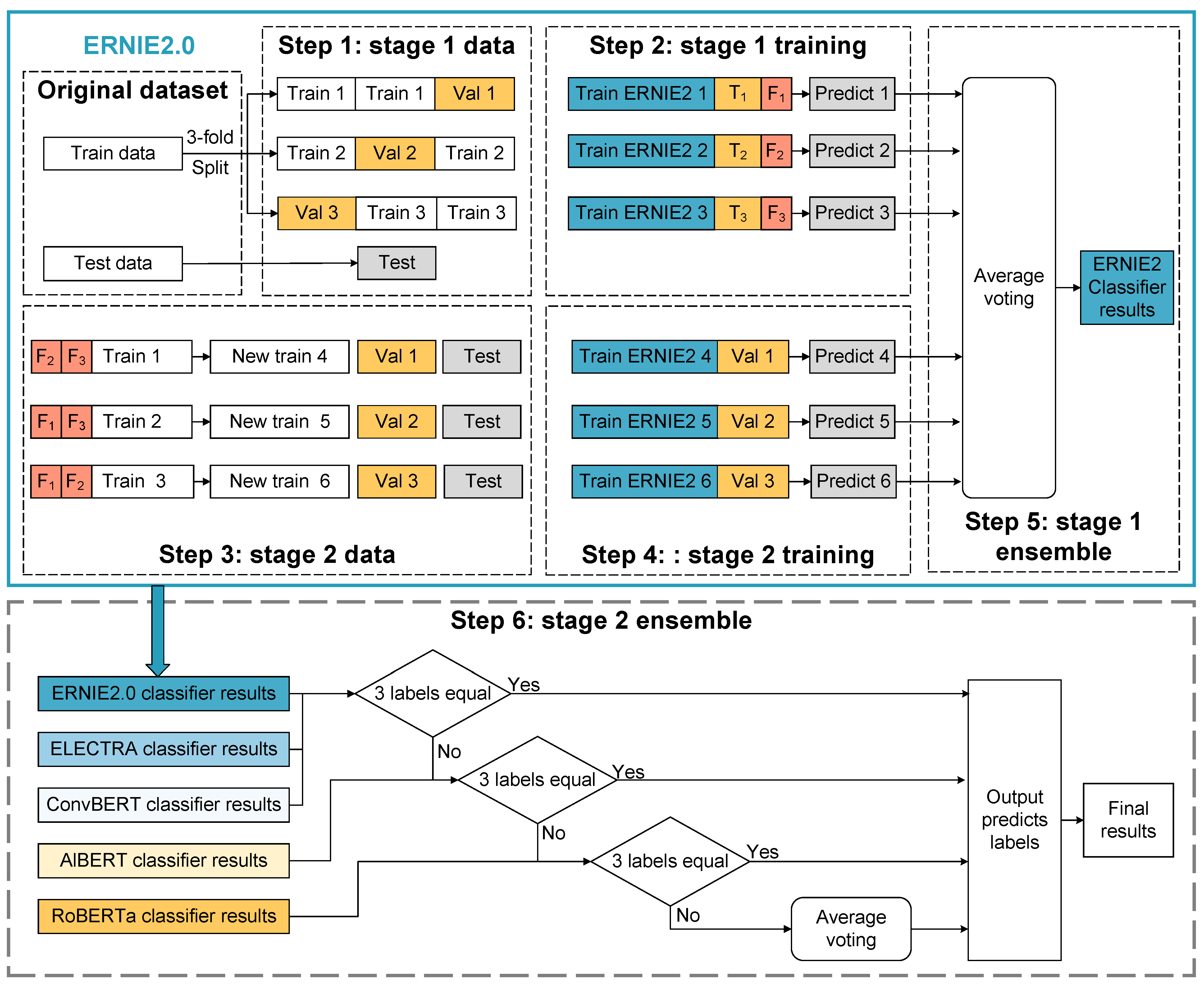
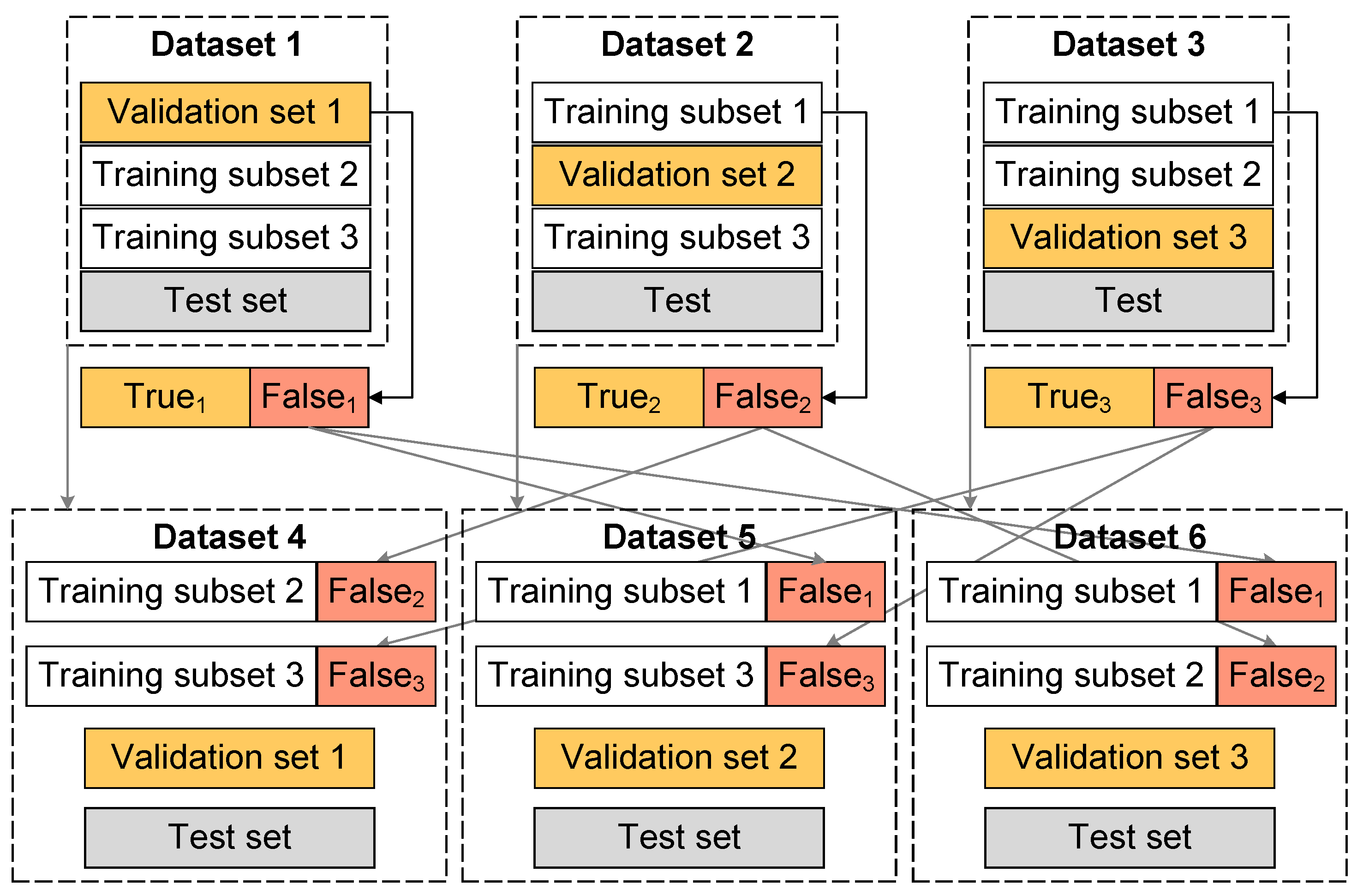

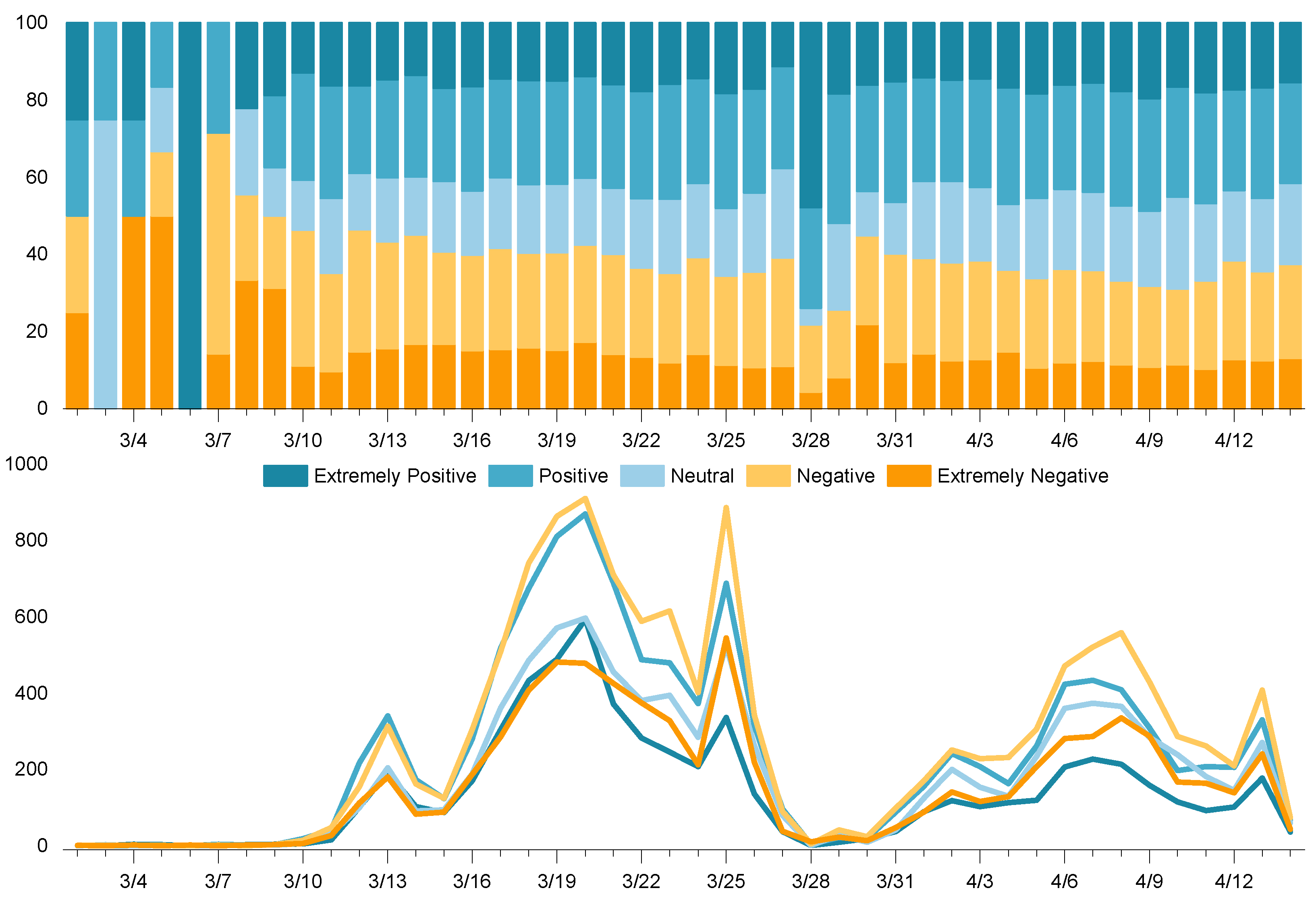

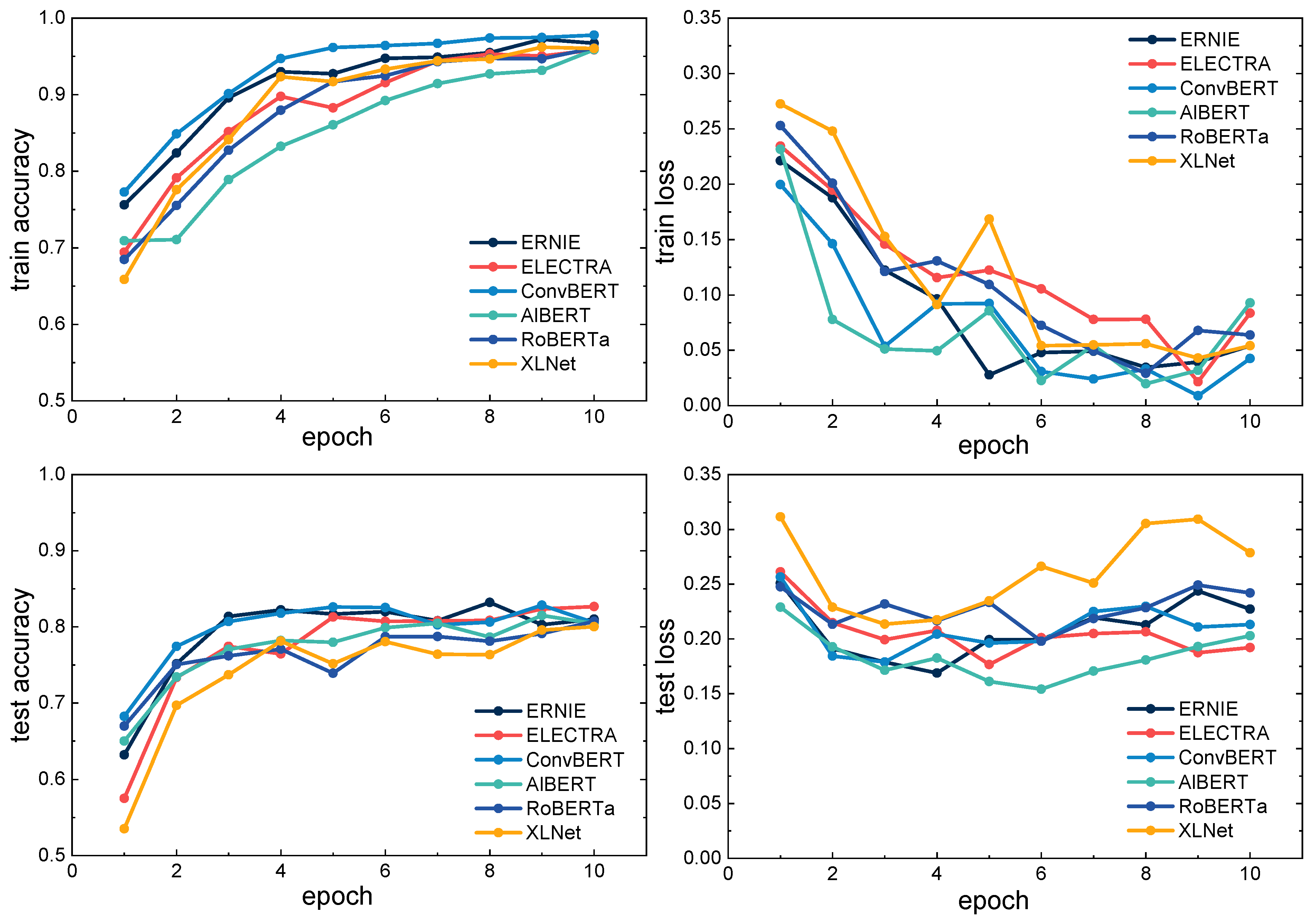
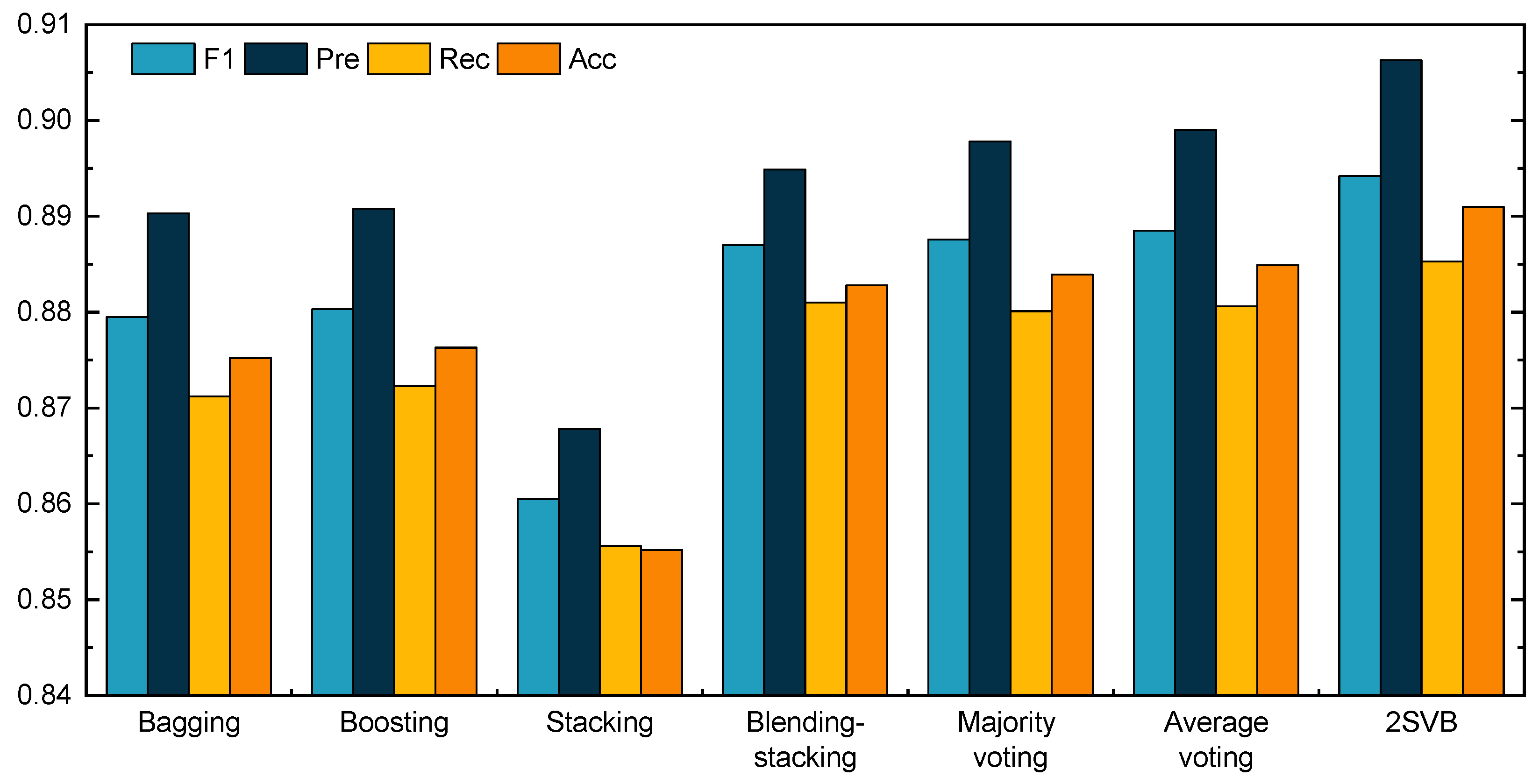

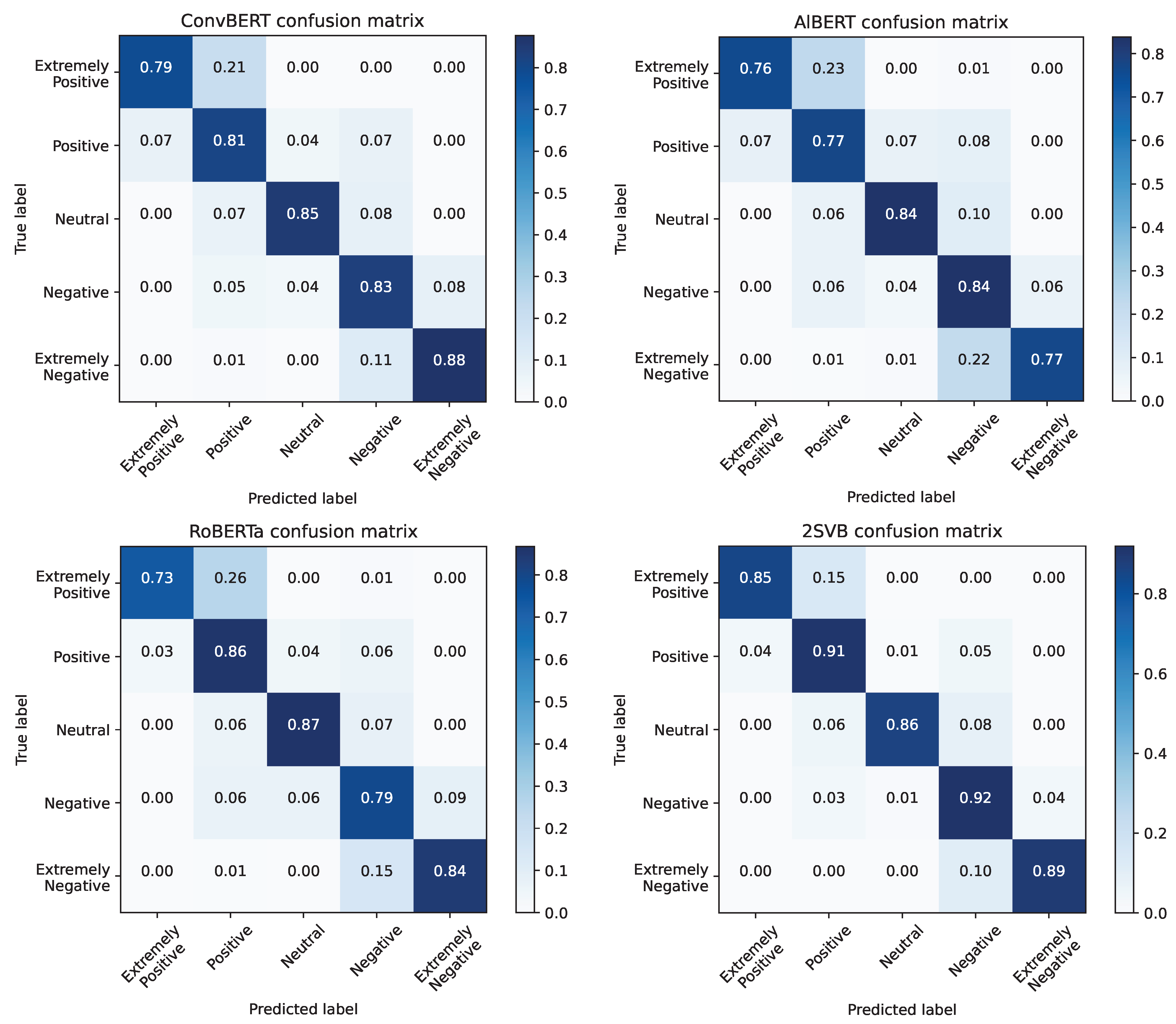
| Model | Training | F1 | Rec | Pre | Acc | |
|---|---|---|---|---|---|---|
| ERNIE | stage 1 training | 1 | 0.8327 | 0.8431 | 0.8258 | 0.8275 |
| 2 | 0.8516 | 0.8610 | 0.8464 | 0.8470 | ||
| 3 | 0.8485 | 0.8637 | 0.8391 | 0.8447 | ||
| stage 2 training | 4 | 0.8501 | 0.8608 | 0.8426 | 0.8444 | |
| 5 | 0.8581 | 0.8664 | 0.8519 | 0.8547 | ||
| 6 | 0.8613 | 0.8681 | 0.8559 | 0.8555 | ||
| ELECTRA | stage 1 training | 1 | 0.8406 | 0.8521 | 0.8333 | 0.8328 |
| 2 | 0.8496 | 0.8531 | 0.8471 | 0.8436 | ||
| 3 | 0.8479 | 0.8568 | 0.8412 | 0.8423 | ||
| stage 2 training | 4 | 0.8473 | 0.8575 | 0.8397 | 0.8418 | |
| 5 | 0.8455 | 0.8480 | 0.8431 | 0.8412 | ||
| 6 | 0.8367 | 0.8443 | 0.8330 | 0.8333 | ||
| ConvBERT | stage 1 training | 1 | 0.8480 | 0.8521 | 0.8451 | 0.8428 |
| 2 | 0.8479 | 0.8520 | 0.8445 | 0.8428 | ||
| 3 | 0.8357 | 0.8402 | 0.8325 | 0.8310 | ||
| stage 2 training | 4 | 0.8436 | 0.8518 | 0.8379 | 0.8394 | |
| 5 | 0.8539 | 0.8655 | 0.8451 | 0.8478 | ||
| 6 | 0.8401 | 0.8459 | 0.8353 | 0.8344 | ||
| AlBERT | stage 1 training | 1 | 0.8024 | 0.8135 | 0.7946 | 0.7975 |
| 2 | 0.8406 | 0.8538 | 0.8316 | 0.8362 | ||
| 3 | 0.8238 | 0.8238 | 0.8249 | 0.8175 | ||
| stage 2 training | 4 | 0.8267 | 0.8336 | 0.8224 | 0.8217 | |
| 5 | 0.8268 | 0.8233 | 0.8317 | 0.8202 | ||
| 6 | 0.8361 | 0.8349 | 0.8392 | 0.8296 | ||
| RoBERTa | stage 1 training | 1 | 0.8132 | 0.8167 | 0.8122 | 0.8065 |
| 2 | 0.8190 | 0.8217 | 0.8173 | 0.8125 | ||
| 3 | 0.8057 | 0.8096 | 0.8025 | 0.7970 | ||
| stage 2 training | 4 | 0.8386 | 0.8423 | 0.8366 | 0.8318 | |
| 5 | 0.8300 | 0.8371 | 0.8253 | 0.8239 | ||
| 6 | 0.8228 | 0.8337 | 0.8179 | 0.8183 | ||
| Classifier Groups | ERNIE2 | ELECTRA | ConvBERT | AlBERT | RoBERTa | Number of Predicted Labels | 1 | 2 | 3 | 4 | 5 |
|---|---|---|---|---|---|---|---|---|---|---|---|
| 1 | ✓ | ✓ | ✓ | Number of samples | 3259 | 531 | 8 | – | – | ||
| 2 | ✓ | ✓ | ✓ | 3166 | 616 | 16 | – | – | |||
| 3 | ✓ | ✓ | ✓ | 3243 | 537 | 18 | – | – | |||
| 4 | ✓ | ✓ | ✓ | 3372 | 413 | 13 | – | – | |||
| 5 | ✓ | ✓ | ✓ | ✓ | 3183 | 588 | 27 | 0 | – | ||
| 6 | ✓ | ✓ | ✓ | ✓ | ✓ | 3045 | 715 | 38 | 0 | 0 |
| Statistic | Neutral | Positive | Extremely Positive | Negative | Extremely Negative | Total |
|---|---|---|---|---|---|---|
| Train | 7713 | 11,422 | 6624 | 9917 | 5481 | 41,157 |
| Test | 619 | 947 | 599 | 1041 | 592 | 3798 |
| Model | Optimizer | Batch Size | Initial lr | Max len |
|---|---|---|---|---|
| Embedding | Adam | 64 | 256 | |
| 1-D Conv | Adam | 64 | 256 | |
| Bi-LSTM | Adam | 64 | 256 | |
| PDL | AdamW | 64 | 256 |
| Index | Classifier Groups | F1 | Rec | Pre | Acc |
|---|---|---|---|---|---|
| 1 | SVM, Embedding, Bi-LSTM | 0.6455 | 0.6523 | 0.6399 | 0.6399 |
| 2 | Bi-LSTM, GPT2, BERT | 0.8089 | 0.8141 | 0.8046 | 0.8025 |
| 3 | Embedding, 1-D Conv, Bi-LSTM, GPT2, BERT | 0.7546 | 0.7671 | 0.7452 | 0.7494 |
| 4 | GPT2, BERT, RoBERTa | 0.8517 | 0.8603 | 0.8448 | 0.8454 |
| 5 | ERNIE, BERT, RoBERTa | 0.8643 | 0.8717 | 0.8584 | 0.8594 |
| 6 | ERNIE, ELECTRA, ConvBERT | 0.8694 | 0.8777 | 0.8630 | 0.8641 |
| 7 | ERNIE, ELECTRA, ConvBERT, RoBERTa | 0.8710 | 0.8809 | 0.8635 | 0.8657 |
| 8 | ERNIE, ELECTRA, ConvBERT, AlBERT, RoBERTa | 0.8712 | 0.8801 | 0.8647 | 0.8657 |
| 9 | ERNIE, ELECTRA, ConvBERT, AlBERT, RoBERTa, XLNet | 0.8677 | 0.8772 | 0.8602 | 0.8628 |
| Base Model | Group | S-1 D 1 | S-2 D 2 | S-1 T 3 | S-2 T 4 | S-1 E 5 | S-2 E 6 | F1 | Rec | Pre | Acc |
|---|---|---|---|---|---|---|---|---|---|---|---|
| BERT | 1 | 3ND 7 | – | BERT*3 9 | – | average voting | – | 0.8641 | 0.8694 | 0.8596 | 0.8586 |
| 2 | 3FD 8 | – | BERT*3 | – | average voting | – | 0.8657 | 0.8774 | 0.8574 | 0.8612 | |
| 3 | 3ND | 3ND | BERT*3 | BERT*3 | average voting | – | 0.8706 | 0.8788 | 0.8641 | 0.8655 | |
| 4 | 3FD | 3ND | BERT*3 | BERT*3 | average voting | – | 0.8737 | 0.8867 | 0.8642 | 0.8699 | |
| 5 | 3FD | 3UD 10 | BERT*3 | BERT*3 | average voting | – | 0.8751 | 0.8870 | 0.8664 | 0.8715 |
| Base Model | Group | S-1 D | S-2 D | S-1 T | S-2 T | S-1 E | S-2 E | F1 | Rec | Pre | Acc |
|---|---|---|---|---|---|---|---|---|---|---|---|
| ERNIE ELECTRA ConvBERT AlBERT RoBERTa | 6 | 3ND | – | every*3 1 | – | average voting | Cascade voting | 0.8820 | 0.8940 | 0.8734 | 0.8786 |
| 7 | 3FD | – | every*3 | – | average voting | Cascade voting | 0.8866 | 0.8945 | 0.8806 | 0.8826 | |
| 8 | 3ND | 3ND | every*3 | every*3 | average voting | Cascade voting | 0.8885 | 0.8990 | 0.8806 | 0.8849 | |
| 9 | 3FD | 3ND | every*3 | every*3 | average voting | Cascade voting | 0.8913 | 0.9028 | 0.8829 | 0.8878 | |
| 10 | 3FD | 3UD | every*3 | every*3 | average voting | Cascade voting | 0.8942 | 0.9063 | 0.8853 | 0.8910 |
Disclaimer/Publisher’s Note: The statements, opinions and data contained in all publications are solely those of the individual author(s) and contributor(s) and not of MDPI and/or the editor(s). MDPI and/or the editor(s) disclaim responsibility for any injury to people or property resulting from any ideas, methods, instructions or products referred to in the content. |
© 2023 by the authors. Licensee MDPI, Basel, Switzerland. This article is an open access article distributed under the terms and conditions of the Creative Commons Attribution (CC BY) license (https://creativecommons.org/licenses/by/4.0/).
Share and Cite
Cui, S.; Han, Y.; Duan, Y.; Li, Y.; Zhu, S.; Song, C. A Two-Stage Voting-Boosting Technique for Ensemble Learning in Social Network Sentiment Classification. Entropy 2023, 25, 555. https://doi.org/10.3390/e25040555
Cui S, Han Y, Duan Y, Li Y, Zhu S, Song C. A Two-Stage Voting-Boosting Technique for Ensemble Learning in Social Network Sentiment Classification. Entropy. 2023; 25(4):555. https://doi.org/10.3390/e25040555
Chicago/Turabian StyleCui, Su, Yiliang Han, Yifei Duan, Yu Li, Shuaishuai Zhu, and Chaoyue Song. 2023. "A Two-Stage Voting-Boosting Technique for Ensemble Learning in Social Network Sentiment Classification" Entropy 25, no. 4: 555. https://doi.org/10.3390/e25040555
APA StyleCui, S., Han, Y., Duan, Y., Li, Y., Zhu, S., & Song, C. (2023). A Two-Stage Voting-Boosting Technique for Ensemble Learning in Social Network Sentiment Classification. Entropy, 25(4), 555. https://doi.org/10.3390/e25040555






